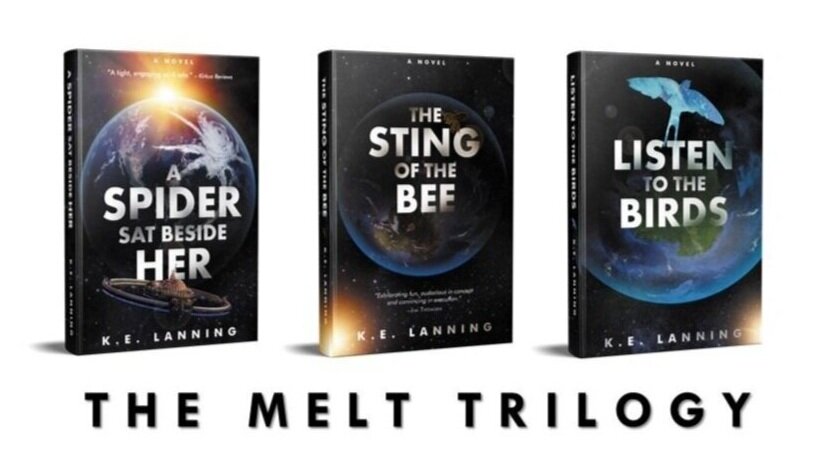JD DeHart Interview with K.E. Lanning on Writing
JD DeHart is a poet, author, and reviewer—he kindly asked to interview me in 2018, but life got involved, I’m only now publishing it on my blog! This interview was just after I’d completed the first book in The Melt Trilogy, A Spider Sat Beside Her, and I was writing the second book, The Sting of the Bee. (JD DeHart’s Interview Questions in Bold)
What drives you to write?
All my life, I’ve been an explorer of ideas—like nuggets of gold, ideas are the jewels of the mind. A creative drive has always been within me; drawing, photography, and even directing an art gallery for several years, but my degree in physics honed my mind to be deductive in thought.
For me, writing is the culmination of all of my creative juices and the desire to dig into the human condition within the framework of a novel. A Spider Sat Beside Her is my debut novel, and the first book within a trilogy of novels on the relationship of humans to the Earth.
What would you like readers to know about your books?
I want readers to come to these novels with an open mind, but leave them with ideas to take away. World building is unique to science fiction and the first novel, A Spider Sat Beside Her, constructs my post-Melt world, and the story is set in motion by these global warming events.
In A Spider Sat Beside Her, with a global event like the catastrophic melting of the ice caps, I needed to convey prospective, so I wrote a series of vignettes, inspired by John Steinbeck’s Grapes of Wrath, where he utilized a narrator’s voice and disembodied voices within the novel to convey the broader context to the Joad family’s story of migration.
Once I build a world, I develop plot using both projections into the future and historical events, because history always repeats itself, given the same catalysts. The entire trilogy is also about what could be—Antarctica being a fresh canvas—I’ve created a world where humans are in balance with nature . . . until some of them decide to take advantage of the fragile power structure.
Please describe your writing process.
I am a non-linear writer—I write in circles rather than in a straight line. I start with a concept and play with that for a while, to develop the big picture. Once I have the setting and initial idea of main characters, then the story begins to roll. In the novel I’m currently writing, The Sting of the Bee, the human urge to escape from a decrepit ‘Old World’ to a ‘New World’ is the seed of the story.
In nuts and bolts, I begin the story for several chapters, then jump to the end, and then return to the middle to complete the manuscript. It’s traditional building of a novel with skeleton, meat, and skin, but perhaps in a different sequence. I’ve found that figuring out the conclusion helps me determine the middle, and also aides with devices such as foreshadowing. I do multiple passes through the manuscript to expand thin spots and create smooth transitions. Many times I have epiphanies of what the novel is trying to say, and add accordingly.
What advice would you offer young writers?
Read the classics, fiction and non-fiction, including writers such as Henry David Thoreau, Margaret Mead, and Malcolm Gladwell. Understand human behavior, economics, science, and politics, to help you to create a novel that has depth and significance. You can have beautiful prose, but it must strike the reader’s heart and mind or, like the old saying, it’s dust in the wind.
Study the craft of writing and endeavor to make your word, your sentence, your paragraph, your chapter—your novel, the best it can be. Figure out your weaknesses and find people to augment those. Develop a very thick skin—it’s not about you—it’s about the writing. Be obsessive, but get it out there.
What are you reading and writing now?
I am currently reading The Year of the Flood, by Margaret Atwood; such a fantastic author!
As far as writing, I am completing the second book in my trilogy, The Sting of the Bee, which is scheduled to launch next year. Weirdly enough, this was the first story I wrote, but I wanted to publish A Spider Sat Beside Her prior to The Sting of the Bee, partially to develop the stage for the subsequent books. However, all of the books within the trilogy are standalone; I didn’t want to leave the reader with a cliffhanger, but have a satisfying ending to each book.
Where can we learn more about you and your books?
I have a website: www.kelanning.com and you can subscribe there to receive published blog articles and updates on my novels. I also have author pages on Goodreads and Amazon.
Thanks so much, JD, for the interview!
K.E. Lanning
Originally published on JD DeHart’s blog and check out JD DeHart's Amazon page
